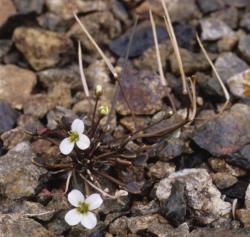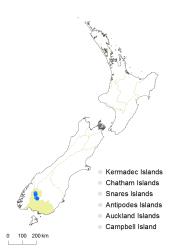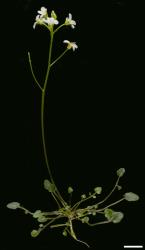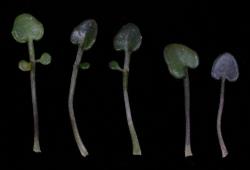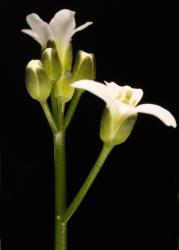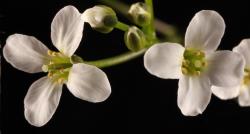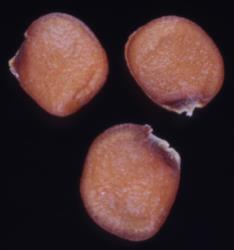Perennial rosette herb, stem and branches c. 2 mm diam. Leaves up to 40 mm long, simple or pinnatisect; lamina 3–13 × 3–8 mm, green-brown to purple-brown, coriaceous, glabrous; terminal pinna 2.0–6.0 × 1.8–8.0 mm, orbicular-reniform to deltoid-reniform, apex obtuse with a small but distinct hydathode; base truncate to cordate. Lateral pinnae 1–2 or absent, 0.8–3.2 × 0.8–2.3 mm, orbicular, petiolule up to 1.2 mm long; petiole up to 32 mm long, plano-convex, glabrous. Cauline leaves sometimes subtending lower pedicels, narrowly obovate, up to 13 mm long. Inflorescence corymbose to corymbose-racemose, with 1–3 lateral corymbs, each corymb 2–8-flowered, flowers sometimes solitary, peduncle up to 100 mm long, 0.6–0.9 mm diam. at base, upright, glabrous, green-brown to purple-brown. Pedicels up to 36 mm long, 0.3–0.5 mm diam., flexuose, ascending to divaricate. Sepals 1.8–2.4 × 1.0–1.8 mm, broadly oblong to ovate, weakly saccate, green, often flushed red-brown, glabrous, margin white and membranous, apex obtuse, base truncate. Petals 4.5–5.0 × 2.6–3.0 mm, white, limb obovate; apex obtuse; base attenuate, tapering into the ± indistinct claw. Stamens 6; median filaments 4, 2.7–3.1 mm long, lateral filaments 2, 2.9–3.5 mm long; anthers 0.6–0.7 mm long, yellow, overtopping the stigma. Ovary 2.7–3.2 mm long, 0.5–0.6 mm diam., ± terete, green, glabrous; ovules 13–14 in each locule; style 0.3–0.5 mm long, ± terete; stigma 0.3–0.4 mm diam. Siliques 12–20 × 0.9–1.2 mm, erect, glabrous, valves green-brown to purple-brown at maturity, style 0.8–1.8 mm long. Seeds 1.0–1.2 mm long, 0.8–0.9 mm wide, 0.3–0.4 mm thick, orbicular to orbicular-oblong, orange-brown; wing absent.
Cardamine serpentina is distinguished from C. glara by its smaller and compact growth habit, smaller green-brown to purple-brown leaves, smaller terminal leaflet with a more distinct cordate base, fewer lateral pinnae, smaller sepals, and shorter siliques.
South Island: Southland.
Cardamine serpentina is restricted to Southland, where it occurs at West Dome, Black Ridge Quarry, Bald Hill, and Livingstone Mountains.
Cardamine serpentina grows on scree and loose stones/rubble around outcrops derived from ultramafic rocks.
Cardamine serpentina is assessed as having a conservation status of Threatened, Nationally Vulnerable B(1) with the qualifier Sparse (de Lange et al. 2018). This assessment of C. serpentina is consistent with its small population sizes, geographical restriction, and specific habitat.
Flowering December–February; Fruiting December–April.
Previously known by the tag name C. “West Dome” (e.g., de Lange et al. 2013, p. 68).



